心灵的巴别塔
程向君绘画作品巡回展
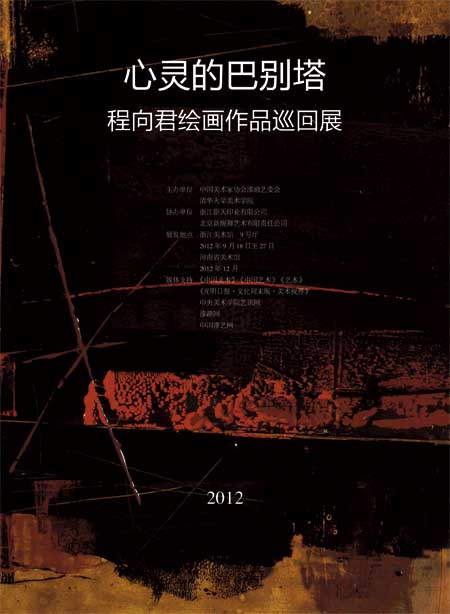
主办单位 中国美术家协会漆画艺委会
清华大学美术学院
协办单位 浙江影天印业有限公司
北京新醒狮艺术有限责任公司
展览地点浙江美术馆9号厅 2012年9月18日至27日
河南省美术馆 2012年12月
媒体支持 《中国美术》《中国艺术》《艺术》
《光明日报文化周末版美术视界》
中央美术学院艺讯网
漆趣网
中华漆艺网
心灵的巴别塔
——程向君的漆画艺术
据说,人类的语言本是相通的,他们妄想齐心协力建造一座通天之塔。这令上帝非常不安,于是变乱了人类的语言,由于无法交流,人类的计划破产了。这座未竟之塔被称为巴别塔,巴别就是“变乱”的意思(创11)。无论这是传说还是神话,语言的隔膜的确造成了文化的差异和交流的障碍。今天,随着人类的交往日益密切,人们一直千方百计地希望打破语言的藩篱,增进彼此之间的了解。绘画是文化的产物,中国人和西方人对彼此的绘画艺术都存在理解上的困难。作为一位漆画艺术家,程向君不仅尝试用绘画性突破传统的漆画语言,更用抽象的表现手法突破艺术中文化的隔膜,可以说,他的作品极大地丰富了当代抽象绘画的审美体验。
程向君1986年毕业于中央工艺美术学院(清华大学美术学院的前身),现执教于清华大学美术学院工艺美术系漆艺工作室。漆艺在中国至少有7000多年的历史,但漆画却是一个非常年轻的画种。尽管从20世纪60年代就有一些艺术家从事漆画创作,但是直到1984年,漆画才被中国美术家协会正式承认为一个独立的画种,并以此身份参加了“第六届全国美术作品展览”。程向君1985年开始学习漆画,可以说,他的创作伴随着中国漆画艺术的成长和发展。在此后的十年中,程向君一直处于熟悉漆画语言和探寻自己风格的过程中。在题材上,他表现静物、风景和人物;在效果上,他追求油画、版画甚至中国画的感觉;在风格上,他借鉴写实主义、立体主义、构成主义乃至彩色玻璃窗的装饰效果;在工艺上,他采用了刻漆、镶嵌和磨漆等各种手法。从中我们不难发现程向君不拘的个性,以及他对待艺术语言的开放心态。不可否认的是,他的漆画艺术逐渐走向成熟,但是仍然没有脱离传统漆画的范畴。
1995年,对程向君而言是个非常重要的转折点。这一年,他在中国美术馆举办了“程向君漆画展”,这是对过去十年漆画探索的总结和梳理。接下来,编著《中国现代美术全集——漆画卷》的工作使他有机会对漆画进行全面考察。对漆画界普遍存在的创作中拘泥于传统漆艺的工序,以及作品题材陈旧的状况的认识,成为程向君大胆变革漆画语言的重要契机。对于绝大多数观众而言,传统漆画的美感是有限的。一方面,由于漆画语言的独特性,不熟悉其制作过程的人很难领略其艺术效果;另一方面,由于大部分漆画创作者过分沉溺于漆画的制作工序,导致作品的艺术性不高。这些都成为制约漆画发展的瓶颈。其实,在观看一幅绘画时,真正引起人们兴趣的是其艺术水准,而非特殊工艺。作为绘画的一种,只有强调其绘画性才能突破漆画语言的局限。这是对漆画存在价值的质疑吗?当然不是。传统的大漆是一种棕褐色的半透明材料,以它为基础调和的各种色彩都融入了一种深沉、厚重的韵味;而大漆本色所具有的半透明效果更是油画、中国画等画种不具备的。因此,程向君非常清醒地意识到,漆画归根到底还要在漆上做文章。在钻研漆画独特语言的同时,程向君从未停止油画创作,既让自己保持对绘画性的敏锐直觉,也让自己不至于陷到繁琐的漆画制作工序中不能自拔。大量的油画写生和创作,显示出他扎实的造型功底,成为他在漆画语言上获得突破的基础。例如,他的油画《荷相》系列,作品介乎具象与抽象之间,由积雪与冰面形成的大面积的黑与白成为画面的主体,其间点缀的败荷的枯枝,既给人冷峭萧瑟之感,又有抽象的构成意味。
在写实绘画中,题材所承载的特定文化内涵往往成为不同文化背景的人理解对方绘画的障碍。我们知道,抽象绘画首先是形式探索的结果,它剔除了绘画中的文学性,强调点线面等绘画基本元素的构成,这让抽象绘画具有了其他表现风格所不具备的普适性。自改革开放至1989年,中国现代艺术的发展非常迅速,但在整体上尚未摆脱对西方现代艺术的模仿和追随。进入90年代,中国的当代艺术日趋呈现出多元的面貌,艺术家在绘画语言的探索和把握上也显得更加自信而从容。但是,抽象绘画在中国从未获得像欧美国家那样重要的地位,比如,抽像表现主义一度在美国成为具有压倒性优势的画派,其他与之相左的风格都受到了压抑。因此,在中国从事抽象绘画创作是需要勇气和耐心的,他们往往是一些执着于纯粹艺术语言、渴望摆脱精神羁绊的艺术家。从这个意义上讲,抽象绘画最终呈现的又不仅仅是外在的形式,而是一种心灵的状态和表征。
20世纪90年代后期,程向君逐渐转向了抽象漆画的创作,将这个古老而又年轻的画种带入了当代艺术范畴,为其赋予了新的活力。根据载体,程向君的抽象漆画作品可以分为两大系列,一个是木板漆画,一个是麻和纸本漆画。事实上,对他而言作品的画种属性已经不再重要,在他的作品中更多体现的是一种对绘画语言的精益求精的追求和自然流淌的心灵直白。这让程向君成为中国当代抽象绘画中一位风格独特的探索者。
在程向君的木板漆画创作中,更多地保留了传统漆画的创作手法,画面的视觉效果也更加丰富。虽然在风格上转向抽象,程向君仍然希望在作品中传达中国文化的内涵。早在1997年,程向君就开始创作《漆书》系列。在创作于2010年的一幅《漆书》绘画里,他更加注重对书法韵味的表现,在金色的背景上,简约的黑色图形暗示书法用笔的效果,并在画面的右上方钤上了自己的名章,使绘画的构图更像一幅中国书法。创作中,他有意识地舍弃了漆艺中最重要的抛光环节,对创作中产生的一些特殊痕迹和肌理加以保留,突出了作品的绘画性特征,避免了漆画给人装饰性和工艺性过强的印象。这种创作手法为程向君在学生中赢得了一个非常形象的绰号——“肌理程”。创作于1999年的《面相》是一幅色彩迷人的绘画,在棕绿色调的背景中,刮擦过的表面隐约透出底层的文字,在强烈的黑白色块中拼贴着相书中的一页,周围辅以率意的红黄线条和色块,使画面拥有一种单纯而神秘的气息,同时也体现了作者对中国传统文化的眷恋与反思。
像很多艺术家一样,程向君对西藏充满向往,曾多次赴藏区写生。在他以西藏为主题创作的系列作品中,《格拉丹东序曲》(2006年)最具代表性。他用自己从古物市场中淘选到的藏文雕版在未干的漆上压印出凸凹的文字,它们更多地是一种文化与精神的象征而非等待释读的内容,同时也成为画面构图的重要组成部分。与绝大多数以写实手法表现的西藏主题相比,程向君的绘画更接近藏文化所臻的精神境界,而非对一个陌生环境和少数民族的猎奇。程向君在绘画中引入雕版印痕的做法,非常类似毕加索在综合的立体主义时期创造的“拼贴”(collage),其目的是联系画面与现实。属于这个系列的作品还有《夏河的回忆》(2004年)与《丹巴之旅》(2004年)等。
《红墙下的记忆》(2009年)所表现的是一种在北京长期生活过的人才有的经历。画面上方占主导地位的斑驳的红色让人想起皇城墙壁上岁月的痕迹,画面下方半透明的棕褐色调中透出的古籍文字,这不仅是漆画独有的效果,同时也隐喻着红墙背后所遮蔽的历史与文明。乍看之下,这件作品很容易让人联想到美国抽像表现主义画家克利福德·斯蒂尔的色域绘画,但是程向君显然有着更多的对画面背后精神世界的思考。
与前面所谈到的具有深厚文化内涵的作品相比,《构成》(2006年)是一幅更加纯粹的抽象绘画。画面中剔除了他常用的拼贴和压印雕版的手法,以黑白红为主调的几何形,悬浮在灰色的背景上,色调和谐幽雅。《晖》(2009年)亦属于纯粹的抽象绘画,整个画面笼罩在红色调里,暗示着被阳光映红的天空。平整的背景与画面左下方大面积刮划出来的表面以及右侧布纹的肌理形成了非常强烈的对比,使画面的视觉效果更为丰富。近年来,程向君一直在不断尝试这类没有任何暗示和隐喻符号的作品,让绘画承载更为直接的心灵沟通的作用。
麻和纸本漆画是程向君近年来对漆画材料的大胆尝试,虽然在表现语言上与木板漆画的区别不是很大,但是产生了很多意想不到的独特效果。绘制于纸本上的漆画,由于载体薄弱,因此对肌理的处理相对简单,漆也上得较薄,大漆的棕褐色调成为画面的主调,但是画面的效果也更加纯粹。在谈到这类作品时,程向君说自己一开始并不知道画面完成后的样子,而是根据用大漆制作底子时产生的偶然效果进行下一步的创作。这段告白,很容易让人联想到当年杰克逊·波洛克带有自动主义痕迹的创作手法。以麻为底的漆画,程向君更强调麻布本身的肌理与漆的对比,他故意保留了麻布本身不规则的边缘,为画面增加了一种浮雕般的感觉。
20世纪70年代以后,西方艺术世界不再以纽约为都,呈现出多中心的格局。90年代以后,中国逐渐成为全球化艺术世界中新崛起的力量,中国艺术家的作品从边缘乃至被忽略的状态下开始引起越来越多的关注。但是,文化的隔膜毕竟难以逾越,中国艺术的影响力仍然是非常有限的。在这样的语境下,程向君的抽象绘画创作更弥足珍贵。他的作品超越了内容的局限和文化的差异,让更多的人可以从中领略中国艺术乃至中国文化的魅力。同时,他也通过这种方式让漆画获得了更加广阔的发展空间,走出传统,进入当代。程向君用绘画重建了一座心灵的巴别塔,在那里,人与人之间的沟通变得自由顺畅。这也是所有艺术家追求的终极目标。
张敢
2012年6月28日
Babel Tower of the Heart
——Cheng Xiangjun’s lacquer painting art
It’s said that with interlinked languages, human beings made concerted effort to build a Babel Tower in the vain hope, which made God nervous. God divided the languages and made them unable to communicate, wrecking their plan. This tower is called Babel Tower, in which Babel means “division” (Genesis 11). No matter it’s a legend or myth, language division did bring cultural difference and communication disorder. Now, with closer contact, human beings always attempt to break the division and increase mutual understanding. Chinese and westerners all have difficulties in understanding each other’s art of painting, a cultural product. As a lacquer painting artist, Cheng Xiangjun not only tries to use its style to break traditional language, but also use more abstract show method to breakthrough cultural division. His works greatly enriched the aesthetic experience of contemporary abstract painting.
Cheng Xiangjun graduated from the Central Academy of Art and Design (forerunner of Academy of Arts & Design, Tsinghua University) in 1986, and now he teaches in the Lacquer Craft Lab of the Department of Art and Crafts, Academy of Arts & Design, Tsinghua University. Lacquer craft has a long history of over 7 thousand years, but lacquer painting is a new painting form. Though some artists started lacquer painting since 1960s, it was formally admitted to be a single painting form by Chinese Artists' Association until 1984, and then take part in “The Sixth National Art Exhibition”. Cheng Xiangjun started lacquer painting learning since 1985, along with the growth and development of Chinese lacquer painting art. During the following ten years, he was in the process of knowing lacquer painting language well and exploring his own style. On the theme, he showed still life, landscapes and figures; in effect, he pursued the feeling of oil painting, engraving and even Chinese painting; in style, he learned from the decorative effect of realism, cubism, constructivism and even stained glass windows; in techniques, he used a variety of methods like carving, inlaying and grinding. Undeniably, his lacquer painting art was becoming more matured, but still couldn’t get away from traditional lacquer painting.
1995 was an important turning point for Cheng Xiangjun. During this year, he held his own art exhibition in the Chinese Art Gallery, summarizing and arranging his lacquer painting exploration of the past ten years. Then, he wholly studied lacquer painting by the chance of writing Chinese Modern Art Works—lacquer painting. Knowing more about the ubiquitous traditional lacquer craft limited techniques and old themes brings him an important opportunity to change lacquer painting language. For most audience, aesthetic feeling about traditional lacquer painting is limited. On the one hand, because of its unique language, people who don’t familiar with its creation-process are hard to appreciate its art effect. On the other hand, most lacquer painters addict themselves to techniques, causing low quality of the art. These are the bottleneck for the development of lacquer painting. In fact, what attracts people when they are appreciating paintings is their aesthetic value but not special techniques. As a painting form, lacquer painting can breakthrough its language limitation only by focusing on its style. Is this a doubt about the existing value of lacquer painting? Of course not. Traditional lacquer is a brown translucent material. All the colors based on it have a deep and heavy flavor, and its translucent effect is not owned by oil painting, Chinese painting, etc. So, Cheng Xiangjun clearly realized that lacquer is the base of the lacquer painting. While studying unique language of lacquer painting, he never stops his oil painting, keeping his sharp intuition of the lacquer painting style and also getting him away from cumbersome lacquer painting processes. A number of sketching and creation of oil paintings show his solid skills of modeling, the base of his breakthrough for lacquer painting language. For example, his oil painting series of Lotus range between concretion and abstraction; large areas of black and white formed by snow and ice are the main body of the screen, decorated with sticks of withered lotus. The screen not only gives an icy and bleak sense, but also a abstract composing meaning.
In realistic paintings, special cultural connotations hosted by the theme are always the barrier for people with different cultural background to understand each other’s works. As we know, abstract paintings are the results of form exploration, eliminating its literalness and emphasizing basic elements like point, line and surface, which bring university that other styles don’t have. From reform and opening-up to 1989, Chinese modern art developed very fast, but were still imitating and following western modern art. Since 1990s, Chinese contemporary art were showing diverse figures and artists were more confident and unhurried in exploring and mastering painting languages. But abstract paintings were never that important here as in Occident, for example, abstract expressionism once had overwhelming advantage in America, other paintings with different styles were all repressed. So doing abstract painting here needs courage and patience, the artists are those who persist in pure artistic language and desire to get rid of spirit fetters. In this sense, abstract paintings finally not only show the outer forms but also the state and token of the heart.
Since late 1990s, Cheng Xiangjun turned to abstract lacquer painting, bringing the old but new painting form into contemporary art and giving it fresh life. According to the carrier, his abstract lacquer paintings could be divided into two series, one is wood painting, and the other is linen and paper painting. Actually, the property of the painting is not that important to him; his works more embodies pursuit of great perception of painting language and natural heart feeling. This made him the unique seeker of Chinese contemporary abstract painting.
In his wood lacquer paintings, he kept traditional creation techniques and made richer visual effects. Though the style became abstract, he still hoped to use his works to convey Chinese culture. Early in 1997, Cheng Xiangjun started his lacquer calligraphy. In the lacquer calligraphy painted in 2010, he paid more attention to show the calligraphy flavor. On the gold background, he used simple black graphics to show the effect of calligraphy, and affixed his own seal on the top right of the screen, making the painting’s composition more like a Chinese calligraphy. During the creation, he deliberately gave up the key link of polishing, kept special traces and textures, highlighting the painting itself and avoiding strengthened decoration and craft. This creation technique brought him a vivid nickname among students—Texture Cheng. Face painted in 1999 was a colorful and charming painting. Among the brown-green background, scraped surface vaguely revealed the underlying text, among black and white color pieced a page from the book which told fortune from physiognomy, surrounding that were random red and yellow lines and lumps, making the screen pure and mysterious, and also showing attachment and reflection about Chinese traditional culture.
Like many artists, Cheng Xiangjun yearns for Tibet, and goes to there for sketching several times. Among his series of Tibet, Geladaindong Overture (2006) is the most typical one. He uses Tibetan engraving panned out from antique market to impress on the wet lacquer to get knaggy words. They are mainly stand for culture and spirit but not content waiting for interpretation, and they are also important component element of the composition. Compared to most realistic portrayal Tibet series, his paintings are closer to the mental realm of Tibetan culture, but not only a adventure of strange environment and minorities. His bringing engraving print into paintings is similar to Picasso’s creation of “piecing” during cubism period, connecting the painting with reality. There are other works belong to this series, such as Memory of Xiahe (2004) and Travel to Danba (2004).
Memory under the Read Wall (2009) shows the experiences belong to people have lived in Beijing for a long time. Patches of red on the top leading position of the painting remind people the life of the imperial city; the ancient text presented under the translucent chocolate brown at the bottom, is not only the unique effect of lacquer painting, but also shows history and culture concealed behind the red wall. At first sight, this work easily reminds people the field painting of American abstraction painter Clifford Steele, but Cheng Xiangjun’s paintings obviously show more reflection about the culture behind the screen.
Compared to works with deep cultural content discussed above, Strcture (2006) is a more purely abstract painting. He eliminates commonly used piecing and engraving printing, and uses black, white and red dominated geometric forms to suspending on the grey background, making the color harmony and elegant. Bright (2009) is also a purely abstract painting, red dominated screen implies the sky flamed by the sun. There is a strong contrast between smooth background, scraped surface on the left bottom, and wove texture on the right, making the visual effect richer. Recently, Cheng Xiangjun is trying this kind of works with no implication and metaphors, and making the painting directly communicate to people’s hearts.
Linen and paper lacquer painting are Cheng’s bold attempt about the material of lacquer painting in recent years. Though there is no big difference on expressing language with wood lacquer painting, but much unimaginable unique effect does exist. Because of the weak carrier, paper lacquer painting does simple dealing with texture and lacquers very thin. Chocolate brown becomes the main color of the painting, bringing purer effect. When talking about works of this series, Cheng Xiangjun said that he don’t know what is the final painting at the beginning, but does his every following creation based on the accidental effect caused by lacquer production. These confess reminds people some kind of automatic creation technique of Jackson Pollock. About linen lacquer paintings, Cheng Xiangjun emphasizes the contrast between linen’s texture and lacquer. He deliberately keeps the irregular edges of linen to add an relief feeling to the paintings.
After 1970s, the capital of Western art world is not New York again, but with multi-centers. After 1990s, China becomes the new rising power of the art world, and works of Chinese artists attract more and more attention from the edge and even ignored state. But cultural division is hard to overcome; the influence of Chinese art is still very limited. In this language situation, abstract painting creation of Cheng Xiangjun is precious. His works are beyond the limitations of the content and cultural differences, making more people know the charm of Chinese art and even Chinese culture. Also by this way, lacquer painting gets a greater developing space, getting out of the tradition and entering the contemporary world. Cheng Xiangjun uses painting to rebuild a Babel Tower of the heart. There, people can communicate freely. This is the ultimate goal of all artists.
Zhang Gan
June, 28th, 2012
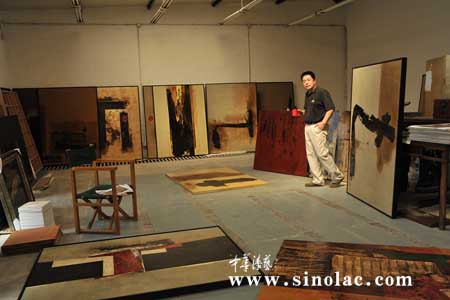
程向君
1961年6月生于沈阳
1986年7月毕业于中央工艺美术学院壁画专业,留校任教。
现任清华大学美术学院副教授、漆艺专业主任、韩国釜山东亚大学交换教授,中国美术家协会漆画艺术委员会副主任、中国工艺美术学会漆艺专业委员会常务理事。
展览
1986年中国现代漆画展
1989年北京第七届全国美术作品展
1992年北京中央工艺美院“程向君漆画展”
1995年北京第八届全国美术作品展览优秀作品展
1995年北京中国美术馆“程向君漆画展”
1997年北京程向君漆画作品展
1998年北京中国美术馆“薄云·程向君作品展”
2000年北京皇史宬“云峰画苑”举办“新视觉——程向君漆画作品展”
2002年北京清华大学工艺美术系画廊“传统的传统——程向君漆画近作展”
2002年广州中国首届青年漆画家提名展
2004年武汉美术文献提名展
2004年南京第十届全国美展漆画作品展
2005年厦门中国漆画双年展
2006年 韩国釜山 国际工艺双年展
2007年广州全国漆画展
2007年厦门第二届中国漆画双年展
2008年北京 798漆千年画廊“回归——程向君漆画近作展”
2008年北京 798尚涂当代画廊“荷相——程向君2008年油画作品展”
2009年上海莫干山双城手工艺术馆“回归——程向君漆画近作展”
2009年北京 798漆千年画廊“映现——程向君漆画新作展”
2009年厦门第十一届全国美展漆画作品展
2009年北京中国美术馆“向祖国汇报----建国60年美术成就展”
2009年济南“全国五所高校手工艺术联展”
2009年北京“城市”——爱尔兰、中国当代艺术交流展
2010年重庆中国当代抽象绘画展
2011年厦门“第三届中国漆画展”
2012年韩国大邱设计家会馆画廊“2012国际漆艺作品展暨国际漆艺研讨会”
2012年北京人民大会堂“上海合作组织峰会-和睦国际美术家绘画作品展”
获奖情况
1986年“中国现代漆画展”优秀作品奖
1989年“第七届全国美术作品展”铜奖
1995年“第八届全国美术作品展”优秀奖
2001年“北京国际艺术博览会”优秀作品奖
2001年“科学与艺术”提名奖
2004年“美术文献学术提名展”提名奖
2001年“全国五所高校手工艺术联展”优秀作品奖
2012年北京“上海合作组织峰会——和睦国际美术家绘画作品展”优秀作品奖
出版物、其他
1996年任《中国现代美术全集·漆画卷》(人民美术出版社)副主编
2004年担任“首届全国漆画展”评委
2004年担任“第十届全国美展”评委
2005年担任韩国清州国际工艺双年展评委
2007年担任第二届中国漆画展评委第二届中国漆画双年展评委
2008年担任第三届中国青年美展评委
2008年任《中国当代漆画精品集》主编,天津人民美术出版社
2009年担任“第十一届全国美展”评委
2009 年担任“全国中小学生美术教师作品展评委”
2010年担任“上海世博会中国美术展漆画展区评委”
2011年担任“第三届中国漆画展评委评委”
收藏
中国美术馆
广东美术馆
韩国现代木工艺博物馆
美术文献艺术中心
韩国统营市漆艺博物馆
e-mail:chengxiangjun88@vip.sina.com
Resume
Chengxiangjun
Mr. Cheng was born in June 1961, in ShenyangProvince. He graduated from China’s Central Arts and Crafts College Mural in July 1986, and then was offered a teaching position. Currently Cheng is the vice professor of Academy of Arts and Design, dean of the Lacquer Craft Lab of the Department of Art and Crafts - Tsinghua University, exchange professor of East Asia University, Busan, South Korea, vice director of the lacquer arts council of the Chinese artists’ association, and also executive director of China arts lacquer community.
Exhibition
1986 China Modern lacquer exhibition
1989 the Seventh National Art Exhibition, Beijing
1992 ‘Chengxiangjun lacquer painting exhibition’, CentralAcademy of Arts & Design, Beijing
1995 The Eighth Excellent Works Exhibition of National Art Exhibition, Beijing
1995 ‘Chengxiangjun laquer painting exhibition’, ChinaArt Museum, Beijing
1997 ‘Chengxiangjun lacquer painting works exhibition’, Beijing
1998 ‘Light Wind-Chengxiangjun painting exhibition’, ChinaArt Museum, Beijing
2000 ‘New Visual-Chengxiangjun lacquer works exhibition’, held by Huangshicheng Cloud summit, Beijing
2002 'Tradition’s tradition-Chengxiangjun lacquer new works exhibition’, the Lacquer Craft Lab of the Department of Art and Crafts, Tsinghua university
2002 The first China nomination exhibition of young lacquer artist, Guangzhou
2002 Korea-China lacquer communication two artist exhibition, Pusan
2003 Response. Nature four artist exhibition, Beijing
2003 Art Bi-annual array exhibition ten art university teachers’ works, Beijing
2003 Beijing Art bi- annual array exhibition of China lacquer painting exhibition Beijing
2004 Teachers’ arts works exhibition of Tsinghua arts college, Tokyo
2004 Times elegant demean arts works exhibition, Beijing
2004 Nomination exhibition of Arts documentary, Wuhuan
2004 The tenth national arts lacquer painting exhibition, Nanjing
2005 9+9 Japan, China, and Korea international exhibition, Tokyo
2005 798 Lacquer gallery ‘exchange and reconstruction’ China contemporary lacquer invitation exhibition, Beijing
2005 ‘China Five universities’ contemporary crafts exhibition’, Beijing
2005 Bi-annual China lacquer painting exhibition, Xiamen
2006 Deagu university international communication exhibition, Korea
2007 National lacquer painting exhibition, Guangzhou
2007 the Second national bi-annual lacquer painting exhibition, Xiamen
2008 798 Thousand year lacquer Gallery, ‘Return – exhibition of Chengxiangjun’s recent lacquer works’, Beijing
2008 798 Shangxu contemporary Gallery, ‘Hexiang - exhibition of Chengxiangjun’s 2008 oil painting works’, Beijing
2009 Mt. Mogan Gallery, ‘Return – exhibition of Chengxiangjun’s recent lacquer works’, Shanghai
2009 798 Thousand year lacquer Gallery, ‘Yingxian - exhibition of Chengxiangjun’s most recent lacquer works’, Beijing
2009 The eleventh national arts lacquer painting exhibition, Xiamen
2009 Chinese Art Mesuem, ‘Report to the Home country – 60th anniversary exhibition of the People’s Republic of China’, Beijing
2009 Collaborative works exhibition of five top universities, Jinan
2009 “The City” – Ireland and China communication exhibition, Beijing
2010 Chinese contemporary abstract painting exhibition, Chongqing
2011 International Art Exhibition of lacquer tree, Taipei
2011 National Theater Gallery, ‘mountain valley shall be - Zhang Ding fellow Art Exhibition, Beijing
2011 National Museum of Bo’ style of Tsinghua University Art Exhibition’, Beijing
2011 the Third Chinese lacquer painting exhibition, Xiamen
2012 Collaborative works exhibition of five top universities, Suzhou
2012 Designers’ Hall Gallery, ‘2012 international lacquer painting exhibition and seminar’, Daegu, South Korea
2012 Great Hall, ‘Shanghai Cooperation Organization summit - International Artists Painting Exhibition’, Beijing
2012 Mt. Mogan Gallery, ‘the Changing tradition – contemporary arts and craft exhibition’, Beijing
Reward
1986 excellent works of ‘China modern lacquer painting exhibition’
1989 bronze reward of ‘the seventh national art works exhibition’
1995 excellent reward of ‘the eighth national art works exhibition’
2001 excellent works of ‘Beijing international arts fair’
2001 nomination reward of ‘Science and Arts’
2004 nomination reward of ‘Arts documentary nomination exhibition’
2011 excellent works of ‘Collaborative works exhibition of five top universities’
2012 excellent works of ‘Shanghai Cooperation Organization summit - International Artists Painting Exhibition’
Thesis, Publication and others
1993Publication on <Art>
1995Publication on <Art>
1993<Chengxiangjun lacquer painting album> published by people’s art publisher
1995Publication in < Artistic and literary circles>
1996 Vice chief editor of <China modern arts collected works. Lacquer collect> published by people’s art publisher
Published thesis <China lacquer painting 40 years>
1999 Special lecture in Seoul Sookmyung Women's University, Paicai university, Pusan donga Univeristy
1999Works published in < China artist >
1999Visiting universities of Germany, France, Austrian, and Italy
2002Exchange professor of Pusan donga Univeristy
2002Works published in <Decoration>
2002Works published in < Arts documentary>
2004Judge of ‘The first national lacquer painting exhibition’
2004Judge of ‘The Tenth national arts exhibition’
2005Judge of Bi-annual international arts and crafts exhibition, qing state, Korea
Publication on < Arts director>
2005Special lecture on international seminar held at Deagu university, Korea
2007Judge of ‘the second national lacquer painting exhibition’ and ‘the second national bi-annual lacquer painting exhibition’
2008Judge of ‘the third China Youth Art Exhibition’
2008Director of ‘Chinese contemporary painting collection’, published by Tianjin people’s art publisher
2009Judge of ‘the eleventh national art exhibition’
2009Judge of ‘national works exhibition of primary and secondary school art teachers’
2010Judge of ‘China lacquer painting exhibition in Shanghai World Expo’
2011Judge of ‘the third China lacquer painting exhibition’
Organiazation collection
China Gallery
Guangdong Gallery
Korea Modern Wood Art Museum
Art documentary Center
Tongyeong Lacquer Art Museum, South Korea
Contact:
Academy of Arts and DesignTsinghuaUniversity
Office:62798958
Mobile Phone:13801028723
Fax:62798827
e-mail:chengxiangjun88@vip.sina.com
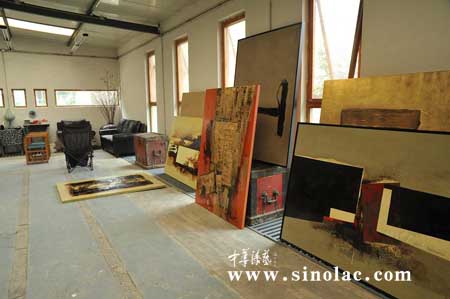
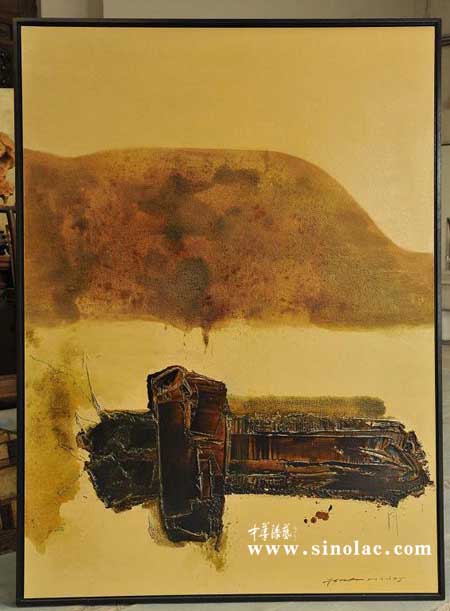
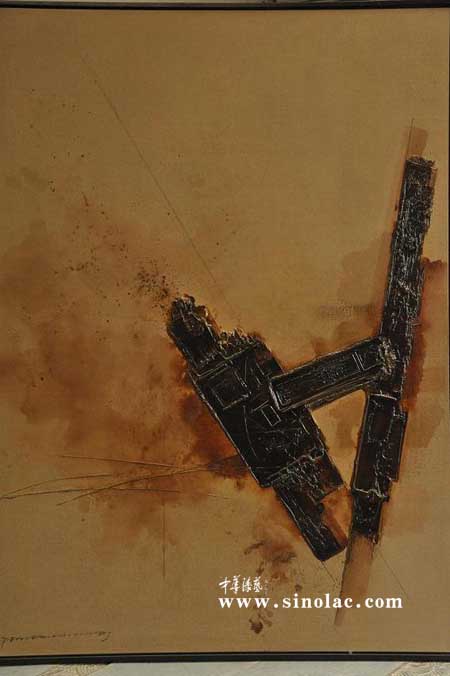
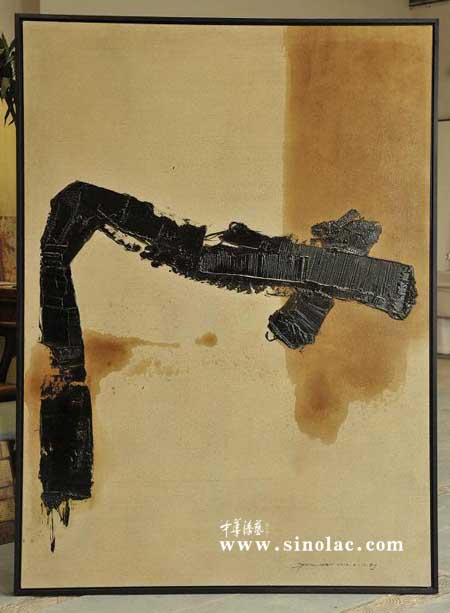
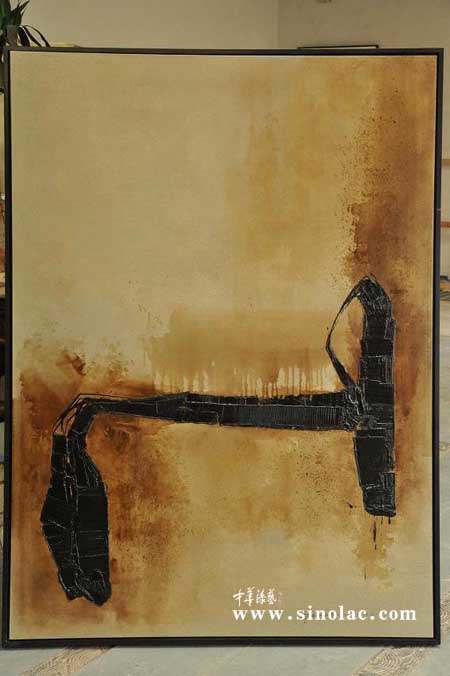
本文由中华漆艺网编辑
|

